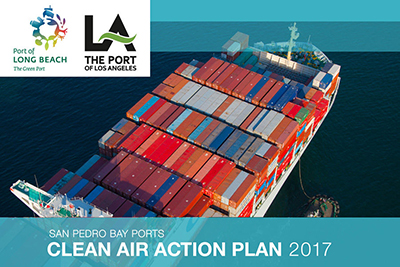PMSA concerned about West Coast port’s competitive position
The letter signed by PMSA Vice-President Thomas Jelenić says the two ports are making insufficient effort to shore up a declining U.S. container market share that dropped from 35.5% in 2006 to 32% in 2016

The Pacific Merchant Shipping Association (PMSA) has criticized a new proposed “Clean Air Action Plan (CAAP)” by the Ports of Los Angeles and Long Beach stating it proposes costly initiatives that will further erode the competitiveness of the two ports.
“Over the past decade, diesel particulate matter emissions are down an incredible 87%,” noted the PMSA in a recent letter. “Even more astonishing, DPM (Diesel Particulate matter) is down 96% for trucks and cargo-handling equipment, the primary focus of this Clean Air Action Plan Update. This leaves 4% of remaining emissions that the CAAP Update proposes to reduce at a cost of $14 billion; a cost that undoubtedly understates the true costs of the CAAP and a cost that puts at risk the 1 in 9 jobs in the region that have made the San Pedro Bay ports the economic engine of Southern California.”
The letter signed by PMSA Vice-President Thomas Jelenić says the two ports are making insufficient effort to shore up a declining U.S. container market share that dropped from 35.5% in 2006 to 32% in 2016, according to American Association of Port Authority data:
“PMSA requests again, given this lack of growth, that before this update to the CAAP is finalized, that staff analyzes the draft for its impact on competitiveness. In addition, the ports should develop a competitiveness goal, and integrate the goal into the CAAP to improve the ability of this gateway to attract and retain cargo.”
Heather Tomley, director of environmental planning at the Port of Long Beach, reacted by stating that the port has solicited and received comments from a wide range of our stakeholders on the Draft Clean Air Action Plan.
“We are reviewing and will take the comments into consideration as we finalize the Plan, which will be considered by our Boards this November,” she said. “We remain committed to building on the successes of the CAAP, protecting public health and the environment as we grow trade and jobs.”
Chris Cannon, director of environmental management at the Port of Los Angeles stated the his port would not comment on the CAAP responses, but acknowledged that “there’s been regular dialogue” about their CAAP concerns.
“We take them very seriously,” he said, “and will consider them carefully as we prepare the final CAAP document.”
PMSA remains critical of the CAAP for pursuing a goal of zero-emissions by electrification: “The CAAP seems focused on driving a single technology outcome: zero-emissions by electrification. This is a mandate that is not necessary to achieve the ports’, regions’, or State’s air emission reduction goals.”
PMSA also said the Ports’ Green House Gas reduction goals were excessive: “As we have already stated, PMSA is concerned that the CAAP seeks to reduce GHG emissions from CHE by 100% by 2030; this is inconsistent with the state’s 80% by 2050 GHG reduction goal and far beyond what is contemplated in the state’s Sustainable Freight Action Plan.”
PMSA said that the Ports have underestimated the costs of converting cargo-handling equipment (CHE) to electrification: “We remain disappointed that the analysis of costs to electrify CHE is based on unfounded assumptions that significantly underestimate total costs.”
Similar sentiment was aired at the 2017 IANA Intermodal Expo in Long Beach. Speaking on a panel examining seaport efficiency, Sal Ferrigno, vice president of SSA Terminals, said placing too much reliance on electrification would be a mistake.
“It’s just not realistic at this point,” he said. “Port stakeholders have to work together with existing recourses to enhance velocity at every stage of the supply chain.”

Article Topics
Ports News & Resources
U.S.-bound import growth track remains promising, notes Port Tracker report Q&A: Port of Oakland Maritime Director Bryan Brandes Signs of progress are being made towards moving cargo in and out of Baltimore New Breakthrough ‘State of Transportation’ report cites various challenges for shippers and carriers in 2024 Industry experts examine the impact of Baltimore bridge collapse on supply chains Port of Baltimore closed indefinitely to ships after 1.6-mile Key Bridge collapses following maritime accident February and year-to-date U.S. import growth is solid, reports S&P Global Market Intelligence More PortsLatest in Logistics
Shipment and expenditure decreases trend down, notes Cass Freight Index March trucking tonnage trends down, reports ATA FTR Shippers Conditions Index enters negative territory DAT March Truckload Volume Index sees modest March gains National diesel average, for week of April 22, is down for the second straight week UPS reports first quarter earnings decline LM Podcast Series: Assessing the freight transportation and logistics markets with Tom Nightingale, AFS Logistics More LogisticsAbout the Author
Subscribe to Logistics Management Magazine

Find out what the world's most innovative companies are doing to improve productivity in their plants and distribution centers.
Start your FREE subscription today.
April 2023 Logistics Management

Latest Resources














